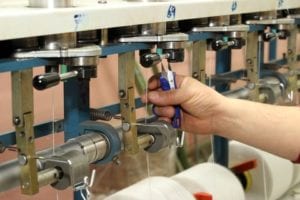Italian Case Illustrates Unusual Way of Tracking Asbestos Exposure

After a mysterious cluster of mesothelioma cases cropped up among Italian textile workers, researchers found an unusual way of tracking asbestos exposure.
Asbestos is the main cause of malignant mesothelioma. Many mesothelioma patients came in contact with asbestos at work. But it is not always clear how it happened.
Mesothelioma legal cases often hinge on tracking asbestos exposure at a negligent company. But in the case of the Italian textile workers, the exposure was not obvious. The workers produced sewing threads. They did not work directly with asbestos.
It was not until an abatement company started removing asbestos from the plant, that researchers got a clearer picture of why the workers got sick.
The Challenge of Tracking Asbestos Exposure
Asbestos is a mineral found in the soil. It is strong, cheap, and resistant to heat and corrosion. For decades, asbestos was mined, packaged, and shipped around the world for use in manufacturing.
The textile industry was one of the industries that sometimes used asbestos in its machinery. Most textile workers did not work directly with asbestos. In cases like these, tracking asbestos exposure can be difficult.
If no one can track the source of the asbestos exposure, workers with mesothelioma may not be able to claim compensation. Even though eleven Tuscan thread makers contracted mesothelioma, the standard way of tracking asbestos exposure turned up nothing.
“Using the common research method, the ROC [Mesothelioma Tracking Organization] had not previously been able to identify the specific sources of asbestos exposure causing such a large cluster,” wrote the researchers.
Asbestos Abatement Provides New Information
Because it is so toxic, asbestos has to be removed by abatement professionals with protective gear. Looking at data from abatement companies made tracking asbestos exposure in the textile plant easier.
The researchers examined the annual reports from asbestos removal companies in the Tuscany Region since 1988. Italian law requires the companies to report how much asbestos they remove and where it comes from.
The team combined this information with interviews with former plant workers. They used all of the data to reconstruct the work environment, tracking asbestos exposure.
“The new collected information depicted a widespread asbestos pollution of the workplace during the period of employment of all cases,” writes lead author Alessia Angelini.
As a result of the research, the eleven mesothelioma cases were reclassified as occupational exposures. This meant the workers could access medical and legal help for mesothelioma patients.
Source:
Angelini, A, et al, “Reconstruction of the asbestos exposure in a textile company producing sewing threads through the use of an unusual information source”, February 27, 2020, Work, Environment, and Health, https://www.mattioli1885journals.com/index.php/lamedicinadellavoro/article/view/8837





